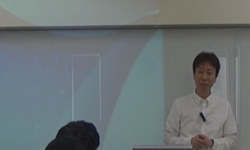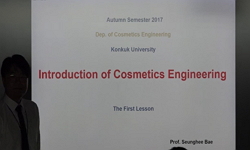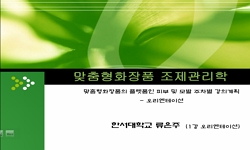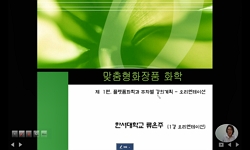미세먼지(Particulate matter, PM)는 피부 장벽의 기능을 저하시키고 염증성 피부 질환 및 외인성노화를 유발하는 대기 오염원이다. 본 연구에서는 대체 미세먼지로서 iron oxide black을 이용하여 화...
http://chineseinput.net/에서 pinyin(병음)방식으로 중국어를 변환할 수 있습니다.
변환된 중국어를 복사하여 사용하시면 됩니다.
- 中文 을 입력하시려면 zhongwen을 입력하시고 space를누르시면됩니다.
- 北京 을 입력하시려면 beijing을 입력하시고 space를 누르시면 됩니다.

부유챔버를 이용한 화장품의 미세먼지 부착방지 효과 평가법 = Evaluation Method of Cosmetics for the Effect of Fine Dust Adhesion Prevention Using Floating Chamber
한글로보기https://www.riss.kr/link?id=A107220223
- 저자
- 발행기관
- 학술지명
- 권호사항
-
발행연도
2020
-
작성언어
-
- 주제어
-
등재정보
KCI등재
-
자료형태
학술저널
-
수록면
319-327(9쪽)
-
KCI 피인용횟수
0
- DOI식별코드
- 제공처
-
0
상세조회 -
0
다운로드
부가정보
국문 초록 (Abstract)
미세먼지(Particulate matter, PM)는 피부 장벽의 기능을 저하시키고 염증성 피부 질환 및 외인성노화를 유발하는 대기 오염원이다. 본 연구에서는 대체 미세먼지로서 iron oxide black을 이용하여 화장품에 의한 미세먼지의 피부 부착 방지효과를 평가하였다. 미세먼지 부유챔버는 피부노출부위, 미세먼지 주입구, 부유동력장치, 배출구로 구성하여 미세먼지가 챔버내에서 부유 중 피부에 자연스럽게 부착될 수 있도록 제작하였다. 대체 미세먼지의 부유농도에 따른 피부 밝기 변화를 확인하여 최적의 부유농도 조건을 확인하였다. Iron oxide black의 피부부착 전·후의 밝기차이 (미세먼지 부착 전 밝기 - 미세먼지 부착 후 밝기, Δ)는 미세먼지의 양에 비례한다. 또한, 화장품 5종에 대하여 각각 20명의 피험자를 대상으로 제품 도포군과 무도포대조군으로 나누어 부유 대체 미세먼지에 대한 피부부착 방지효과를 확인하였다. 피부에 부착된 iron oxide black의 전·후 밝기 차이를 계산하여 대조군과 비교분석하였다(p < 0.05). 시험에 최소 150 mg 이상의 iron oxide black을 사용할 때 농도에 따른 피부 밝기 변화 양상이 뚜렷하게 나타났다. 최적의 부유농도에서 피부와 대체미세먼지의 밝기 간섭이 적고 피부 부착 패턴이 선명하게 나타났다. 5종의 화장품을 피부에 도포할 경우 iron oxide black의 부착양이 대조군에 비해 통계적으로 유의하게 낮았다. 이는 제품에 따라 iron oxide black의 부착을 방지 함을 의미한다. 본 연구는 대체 미세먼지로서 iron oxide black의 피부 부착양상을 확인하고, 화장품에 의한 부착 방지효과를 평가하는 안전하고 유용한 방법이다. 화장품의 다양한 제형이나 원료의 특성에 따라 미세먼지가 피부에 부착되는 것을 방지할수 있음을 확인하였다.
다국어 초록 (Multilingual Abstract)
Particulate matters (PM) are small particulate pollution that decrease the function of skin barrier, which causes inflammatory skin diseases and extrinsic aging. In this study, we evaluated the effect of preventing the adherence of PMs from several co...
Particulate matters (PM) are small particulate pollution that decrease the function of skin barrier, which causes inflammatory skin diseases and extrinsic aging. In this study, we evaluated the effect of preventing the adherence of PMs from several cosmetic products applied to human skin using iron oxide black. The PM floating chamber consists of skin exposure area, PM inlet, floating power device, and an outlet so that PM can be naturally attached to the skin while floating in the chamber. The change in skin brightness according to the floating concentration of alternative fine dust was checked to confirm the optimal floating concentration conditions. The intensity difference (before-after intensity, Δ) before and after adhesion of iron oxide black was proportional to the amount of PM adhered. The anti-adherence effect of iron oxide black on five cosmetic products were evaluated through 20 each subjects by comparing the amount of iron oxide black adhered on the control and treatment. The difference in brightness before and after the iron oxide black attached to the skin was calculated and compared with the control group(p < 0.05). When over 150 mg of iron oxide black was adhered on the skin, the interference of intensity was low and clearly showed the skin adhered pattern. According to the application of the five cosmetics, the intensity difference was significantly lower than the control group. This means that depending on the product, it prevented the attachment of iron oxide black. This study is a safe and useful method to confirm the prevention of PM skin adherence. In conclusion, cosmetics can prevent the adherence of PM on the skin according to the formulation or ingredients characteristics.
참고문헌 (Reference)
1 T. L. Pan, "The impact of urban particulate pollution on skin barrier function and the subsequent drug absorption" 78 (78): 51-, 2015
2 D. Loomis, "The carcinogenicity of outdoor air pollution" 14 (14): 1262-, 2013
3 W. Barthlott, "Purity of the sacred lotus, or escape from contamination in biological surfaces" 202 (202): 1-, 1997
4 J. K. Seok, "Punicalagin and (–)-epigallocatechin-3-gallate rescue cell viability and attenuate inflammatory responses of human epidermal keratinocytes exposed to airborne particulate matter PM10" 31 (31): 134-, 2018
5 S. H. Hwang, "Potential importance of ozone in the association between outdoor air pollution and dry eye disease in South Korea" 134 (134): 503-, 2016
6 W. E Roberts, "Pollution as a risk factor for the development of melasma and other skin disorders of facial hyperpigmentation - is there a case to be made?" 14 (14): 337-, 2015
7 L. Giacomelli, "In vivo validation of the multicomponent powder (Vitachelox®) against the deposition of polluting ions" 11 (11): 109-, 2018
8 T. Schneider, "Conceptual model for assessment of dermal exposure" 56 (56): 765-, 1999
9 Y. C. Boo, "Can plant phenolic compounds protect the skin from airborne particulate matter?" 8 (8): 379-, 2019
10 M. Portugal-Cohen, "Antipollution skin protection - a new paradigm and its demonstration on two active compounds" 10 (10): 185-, 2017
1 T. L. Pan, "The impact of urban particulate pollution on skin barrier function and the subsequent drug absorption" 78 (78): 51-, 2015
2 D. Loomis, "The carcinogenicity of outdoor air pollution" 14 (14): 1262-, 2013
3 W. Barthlott, "Purity of the sacred lotus, or escape from contamination in biological surfaces" 202 (202): 1-, 1997
4 J. K. Seok, "Punicalagin and (–)-epigallocatechin-3-gallate rescue cell viability and attenuate inflammatory responses of human epidermal keratinocytes exposed to airborne particulate matter PM10" 31 (31): 134-, 2018
5 S. H. Hwang, "Potential importance of ozone in the association between outdoor air pollution and dry eye disease in South Korea" 134 (134): 503-, 2016
6 W. E Roberts, "Pollution as a risk factor for the development of melasma and other skin disorders of facial hyperpigmentation - is there a case to be made?" 14 (14): 337-, 2015
7 L. Giacomelli, "In vivo validation of the multicomponent powder (Vitachelox®) against the deposition of polluting ions" 11 (11): 109-, 2018
8 T. Schneider, "Conceptual model for assessment of dermal exposure" 56 (56): 765-, 1999
9 Y. C. Boo, "Can plant phenolic compounds protect the skin from airborne particulate matter?" 8 (8): 379-, 2019
10 M. Portugal-Cohen, "Antipollution skin protection - a new paradigm and its demonstration on two active compounds" 10 (10): 185-, 2017
11 S. S. Amaral, "An overview of particulate matter measurement instruments" 6 (6): 1327-, 2015
12 L. Wang, "Air quality strategies on public health and health equity in europe-a systematic review" 13 (13): 1196-, 2016
13 World Health Organization, "Air Quality Guidelines" World Health Organization Regional Office for Europe 2000
14 K. E. Kim, "Adverse effects of airborne particulate matter on various skin diseases" 152 (152): 126-, 2016
15 M. V. R. Velasco, "Active ingredients, mechanisms of action and efficacy tests of antipollution cosmetic and personal care products" 54 (54): e01003-, 2018
동일학술지(권/호) 다른 논문
-
n-Hexane 및 Ethyl Acetate를 이용한 Willamette 품종 라즈베리추출물의 페놀 화합물 함량 및 항산화 효능 연구
- 대한화장품학회
- 박규근 ( Kyu Kun Park )
- 2020
- KCI등재
-
섬모시풀(Boehmeria nivea var. nipononivea) 추출물의 항산화, 항균 및 항염증 효과에 대한 연구
- 대한화장품학회
- 정기수 ( Gi Soo Jung )
- 2020
- KCI등재
-
상업용 β-glucanase를 이용한 홍삼유래 사포닌으로부터 Ginsnoside Rd 의 생물 전환
- 대한화장품학회
- 강혜정 ( Hye Jung Kang )
- 2020
- KCI등재
-
- 대한화장품학회
- 노경백 ( Kyung-baeg Roh )
- 2020
- KCI등재
분석정보
인용정보 인용지수 설명보기
학술지 이력
| 연월일 | 이력구분 | 이력상세 | 등재구분 |
|---|---|---|---|
| 2027 | 평가예정 | 재인증평가 신청대상 (재인증) | |
| 2021-03-19 | 학회명변경 | 한글명 : 대한화장품학회 -> 사단법인 대한화장품학회 |  |
| 2021-01-01 | 평가 | 등재학술지 유지 (재인증) |  |
| 2018-01-01 | 평가 | 등재학술지 유지 (등재유지) |  |
| 2015-01-01 | 평가 | 등재학술지 선정 (계속평가) |  |
| 2013-01-01 | 평가 | 등재후보 1차 FAIL (등재후보1차) |  |
| 2012-01-01 | 평가 | 등재후보학술지 유지 (기타) |  |
| 2011-01-01 | 평가 | 등재후보학술지 유지 (등재후보2차) |  |
| 2010-01-01 | 평가 | 등재후보 1차 PASS (등재후보1차) |  |
| 2009-01-01 | 평가 | 등재후보학술지 유지 (등재후보1차) |  |
| 2007-01-01 | 평가 | 등재후보학술지 선정 (신규평가) |  |
학술지 인용정보
| 기준연도 | WOS-KCI 통합IF(2년) | KCIF(2년) | KCIF(3년) |
|---|---|---|---|
| 2016 | 0.45 | 0.45 | 0.4 |
| KCIF(4년) | KCIF(5년) | 중심성지수(3년) | 즉시성지수 |
| 0.35 | 0.38 | 0.531 | 0.02 |





 ScienceON
ScienceON KISS
KISS





